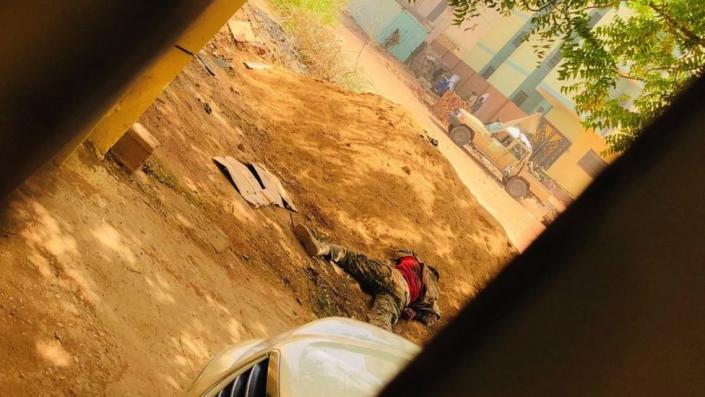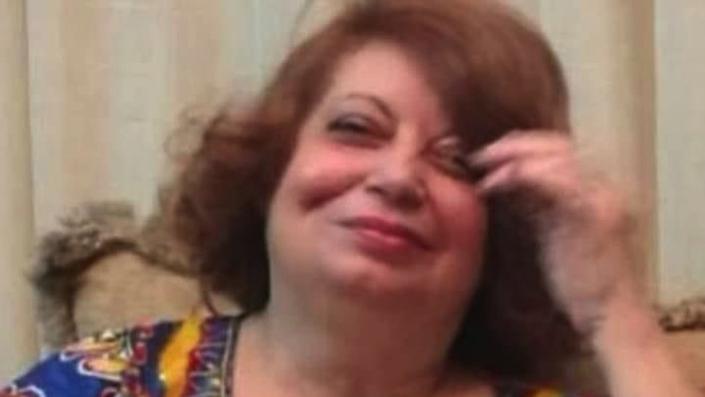
After seven weeks of a bitter battle for control of the Sudanese capital, some residents of Khartoum are grappling with a problem they had never considered: what to do with all the corpses piling up in the streets of the city.
Disclaimer: This story contains graphic photographs and description throughout.
“I buried three people in their own houses, and the others just at the entrance to the road where I live,” said Omar, whose name we have changed.
“It’s better than opening the door and seeing a dog chew on part of a corpse.”
No one knows how many people have died so far, but it is thought to be well over 1,000, including many civilians caught in the crossfire.
With two military factions – the regular army and the paramilitary group the Rapid Support Forces (RSF) – fighting each other despite various ceasefires, it is far too dangerous to try to visit a graveyard.
Omar buried at least 20 people.
“A neighbor of mine was killed in his house. There was nothing I could do but remove the ceramic tiles from his house, dig a grave and bury him,” he told the BBC. .
“The corpses are decomposing in the heat. What can I say? Some neighborhoods in Khartoum are now turning into cemeteries.”
Last month, Omar dug graves for four people near a road a few meters from his house in the al-Imtidad neighborhood of Khartoum. He said he knew others who had to do the same in nearby neighborhoods.
“Many of those killed were buried in areas near the University of Khartoum near Seddon gas station, a well-known landmark. Other bodies were buried in areas near the road Mohammad Naguib.”

There are no official figures on the number of people buried in homes or neighborhoods in Sudan, but Omar said “it could be dozens”.
Hamid, whose name we have also changed, has a similar experience.
He told the BBC he buried three members of the army in a communal area in the town of Shambat, 12 km (7.5 miles) from the capital, after a military plane crashed.
“I was in the area by chance. A group of five people and I removed the bodies from the rubble and buried them in an area surrounded by residential buildings.”
Hamid, an estate agent who has lived in the area for 20 years, said it was a “work of mercy”.
“Where we bury the dead is not important,” he said.
“Burying them is the priority. It’s a charitable thing to do. The journey to the graves [in cemeteries] could take days and snipers are everywhere.
“We are trying to help society avoid a health catastrophe. It is a religious and moral duty.”
“Bury the truth”
Despite good intentions, these actions could unwittingly destroy evidence of war crimes, said the head of the doctors’ union, Dr Attia Abdullah Attia.
He warned that these “hobbyist” burial methods could “bury the truth”, adding that clues to how people died could be destroyed.
Dr Attia said bodies should be identified and buried in graves in a timely manner and with dignity.
He insisted that people should leave the burial process to the health authorities, the Red Cross and the Sudanese Red Crescent.
“Burying the dead in this way is not justified. The burial process should have the presence of government officials, prosecutors, medical examiners and the Red Cross. It is also important to take DNA samples.
When asked why he thought it would be possible to follow these practices in a country where the healthcare system and law and order had broken down, he said foreign countries should play a role.
The two volunteers, Omar and Hamid, both said they took pictures of the faces and bodies of the dead before burying them, which could help with their identification in the future.
But Dr Attia also warned that unsafe burials could lead to the spread of disease.
“Burying the dead at a shallow level makes graves more likely to be dug up by stray dogs. The correct way of burying is not enforced here, as a solid object or bricks must be placed in the grave to prevent the bodies from being exposed. “, he told the BBC.
Hamid, however, says most Sudanese know how to dig a grave where bodies are placed “at least a meter underground”.
Organized efforts to bury the bodies are underway.
A man, whom we call Ahmed, volunteers with the Red Cross to remove bodies from the streets.
“I take pictures of the face and the body, record if it is a new corpse or if it has decomposed [and] give him a number.”
He said they kept a file for each body for future identification.
Despite Dr Attia’s criticism, people feel they have no choice because of the collapse of the public health infrastructure.

On May 11, videos circulated on social media showing the burial of two Sudanese female doctors, Magdolin and Magda Youssef Ghali, in their garden.
Their brother, who we do not name, told the BBC in a video call that burying his two sisters in the house was “the only solution”.
“They remained almost 12 days without burial”, says the brother in tears.
“Neighbors reported a foul smell coming from the house, so people volunteered to bury them in a grave in the garden.”
Health authorities worked with the Red Cross and the Sudanese Red Crescent to move the bodies to cemeteries. But fighting has hampered the arrival of burial teams.
As people try to survive and bury their dead with dignity, the idea of a war crimes tribunal seems like a distant possibility amid so much violence and loss.
The story of the siblings captures the horror people face every day.
“My sisters were buried in a hole in their garden. I never imagined that would be their end,” their brother said.
